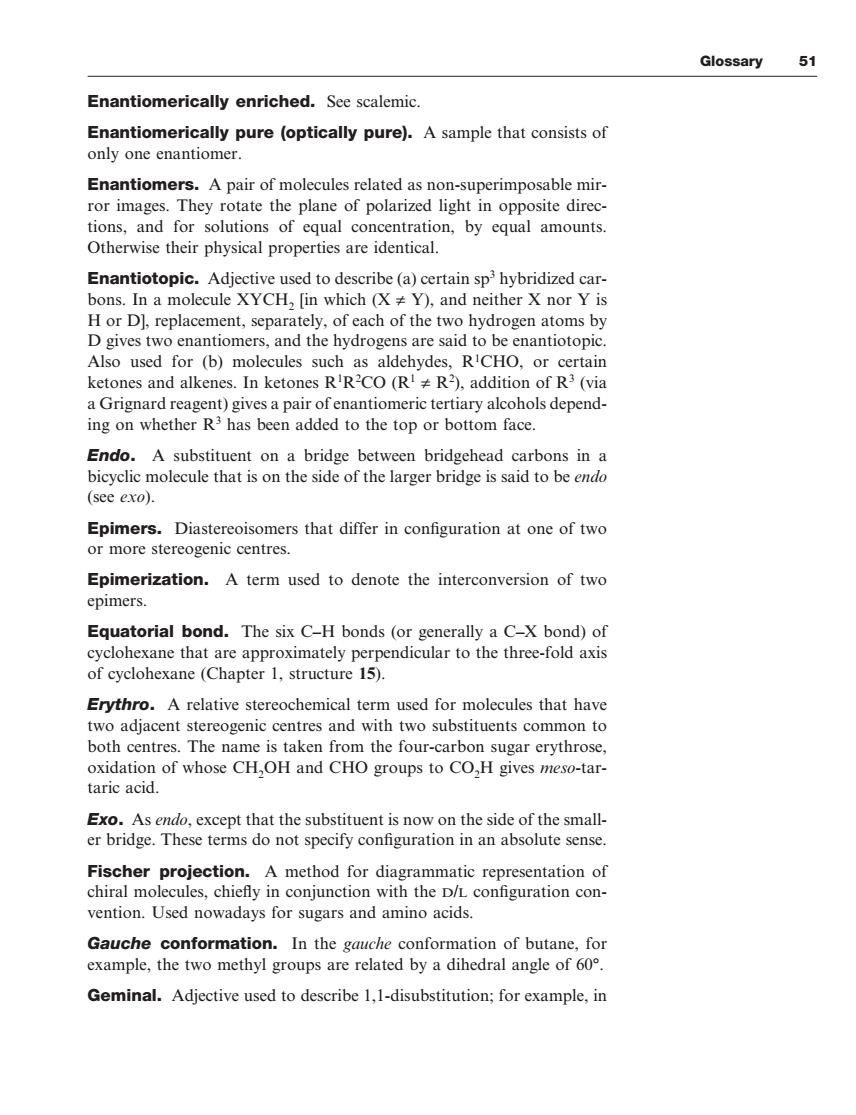正在加载图片...

Glossary 51 Enantiomerically enriched.See scalemic Enantiomerically pure (optically pure).A sample that consists of only one enantiomer. Enantiomers.A pair of molecules related as non-superimposable mir- ror images.They rotate the plane of polarized light in opposite direc tions,and for solutions of equal concentration,by equal amounts. Otherwise their physical properties are identical. Enantiotopic.Adiective used to describe(a)certain sp hybridized car. neither X nor Y is D gives two enantiomers,and the hydrogens are said to be enantiotopic. Also used for (b)molecules such as aldehydes,R'CHO,or certain ketones and alkenes.In ketones R'R'CO (R'+R2).addition of R3(via a Grignard rea eric tertiary alcohols depend- ing on whether Rhas been added to the top or bottom g Endo.A substituent on a bridge between bridgehead carbons in a bicyclic molecule that is on the side of the larger bridge is said to be endo (see exo). Epimers.Diastereoisomers that differ in configuration at one of two or more stereogenic centres. Epimerization.A term used to denote the interconversion of two epimers. Equatorial bond.The six C-H bonds(or generally a C-X bond)of cyclohexane that are approximately perpendicular to the three-fold axis of cyclohexane(Chapter 1,structure 15). Erythro.A relative stereochemical term used for molecules that have two adjacent stereoge enic both centre entres and with two substituents common to The name is taken fro m the four-carbon sugar erythrose oxidation of whose CH,OH and CHO groups to CO,H gives meso-tar- taric acid. Exo.As endo,except that the substituent is now on the side of the small- er bridge.These terms do not specify configuration in an absolute sense. Fischer projection.A method for diagrammatic representation of chiral molecules,chiefly in conjunction with the D/L configuration con- vention.Used nowadays for sugars and amino acids. Gauche conformation.In the ga wche conformation of butane for example,the two methyl groups are related by a dihedral angle of 60 Geminal.Adjective used to describe 1,1-disubstitution;for example,in Enantiomerically enriched. See scalemic. Enantiomerically pure (optically pure). A sample that consists of only one enantiomer. Enantiomers. A pair of molecules related as non-superimposable mirror images. They rotate the plane of polarized light in opposite directions, and for solutions of equal concentration, by equal amounts. Otherwise their physical properties are identical. Enantiotopic. Adjective used to describe (a) certain sp3 hybridized carbons. In a molecule XYCH2 [in which (X ≠ Y), and neither X nor Y is H or D], replacement, separately, of each of the two hydrogen atoms by D gives two enantiomers, and the hydrogens are said to be enantiotopic. Also used for (b) molecules such as aldehydes, R1 CHO, or certain ketones and alkenes. In ketones R1 R2 CO (R1 ≠ R2 ), addition of R3 (via a Grignard reagent) gives a pair of enantiomeric tertiary alcohols depending on whether R3 has been added to the top or bottom face. Endo. A substituent on a bridge between bridgehead carbons in a bicyclic molecule that is on the side of the larger bridge is said to be endo (see exo). Epimers. Diastereoisomers that differ in configuration at one of two or more stereogenic centres. Epimerization. A term used to denote the interconversion of two epimers. Equatorial bond. The six C–H bonds (or generally a C–X bond) of cyclohexane that are approximately perpendicular to the three-fold axis of cyclohexane (Chapter 1, structure 15). Erythro. A relative stereochemical term used for molecules that have two adjacent stereogenic centres and with two substituents common to both centres. The name is taken from the four-carbon sugar erythrose, oxidation of whose CH2 OH and CHO groups to CO2 H gives meso-tartaric acid. Exo. As endo, except that the substituent is now on the side of the smaller bridge. These terms do not specify configuration in an absolute sense. Fischer projection. A method for diagrammatic representation of chiral molecules, chiefly in conjunction with the D/L configuration convention. Used nowadays for sugars and amino acids. Gauche conformation. In the gauche conformation of butane, for example, the two methyl groups are related by a dihedral angle of 60°. Geminal. Adjective used to describe 1,1-disubstitution; for example, in Glossary 51